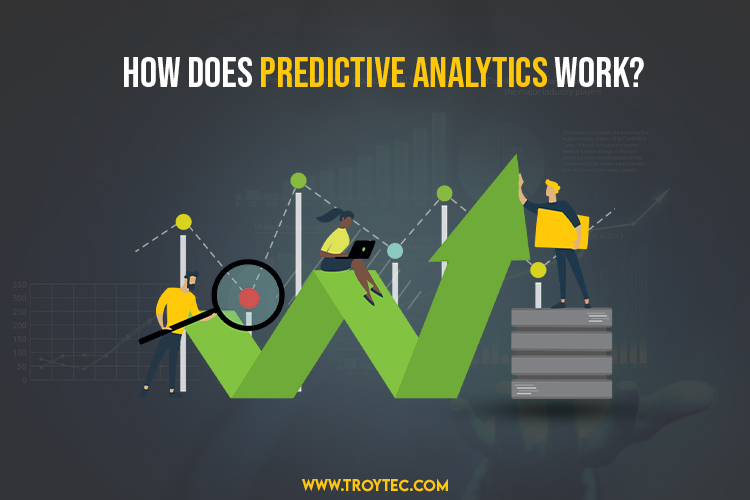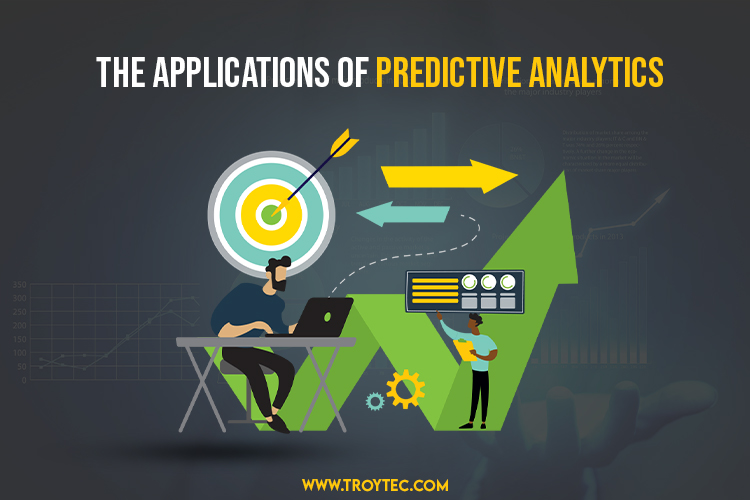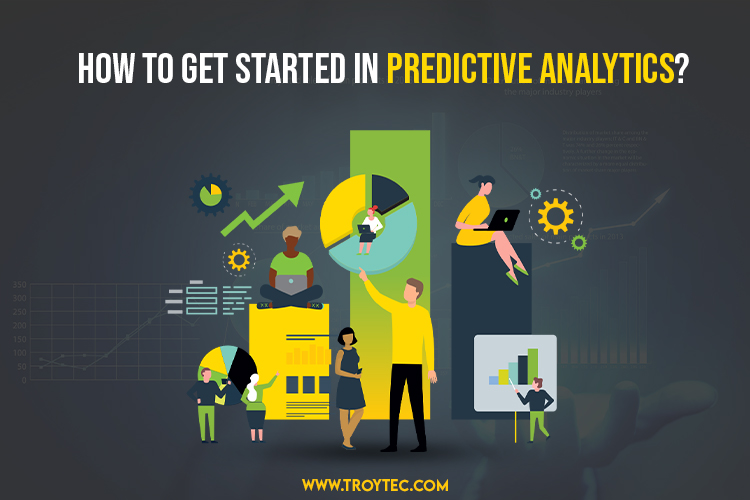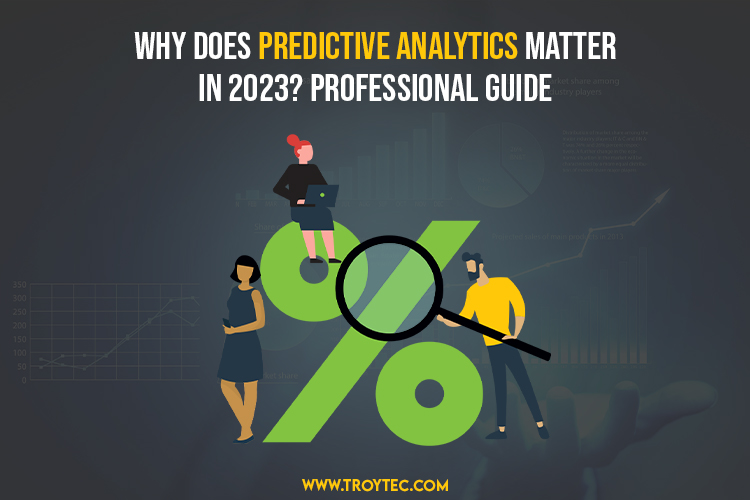What is Predictive Analytics?
This branch of advanced analytics employs historical data combined with data mining techniques, statistical modeling, and machine learning to forecast future outcomes. Businesses use predictive analytics to find patterns in this data and identify risks and opportunities.
It is often associated with big data and data science. Today’s enterprises are swimming in data that resides in transactional databases, equipment log files, images, videos, sensors, or other data sources. To gain insights from this data, data scientists use deep learning and machine learning algorithms to find patterns and predict future events.
These contain linear and nonlinear regression, support vector machines, neural networks, and decision trees. Learnings gained through predictive analytics can be further used to drive actions based on predictive analytics. Predictive analytics uses data and statistical techniques such as machine learning (ML) and predictive modeling to predict outcomes.
Predictive analytics professionals can identify industry trends and behaviors by examining patterns in large amounts of data. These forecasts provide valuable insights that lead to more informed business and investment decisions.
How does predictive analytics transform data into meaningful insights?
Data mining, machine learning, and statistical modeling are the technologies and processes that make this possible. Data mining is used to sift large data sets (big data) to reveal relationships and yield relevant insights. Organizations use it to improve efficiency, increase profits, and protect information.
Advances in tools such as ML allow experts to compute complex analyses, make assumptions, and retest and re-evaluate models using massive data sets. No additional programming is required. Healthcare, manufacturing, and other industries are increasingly interested in predictive analytics to help improve business performance.
Expanding predictive analytics can significantly improve efficiency, patient care, and well-being in the healthcare industry. According to research, the global healthcare analytics market was valued at approximately $1.6 billion in 2018. For this, the compound annual growth rate of 14.56% from 2019 to 2025. It will be about 42% by 2025, which is expected to generate billions of dollars.
In manufacturing, predictive analytics models can improve efficiency and profitability. Predictive analytics can predict production delays by indicating the location and frequency of machine failures. By predicting future demand, manufacturers can accurately order supplies, thus reducing raw material waste.
How does predictive analytics work?

To take advantage of predictive analytics, organizations must first define their business goals, such as increasing revenue, optimizing operations, or improving customer engagement. Then, with the right software solution, that organization can classify large amounts of disparate data, develop predictive analytics models, and generate actionable insights that support that goal.
From a scientific perspective, predictive analytics are part of the natural advance of our understanding and serve the purpose of defining, clarifying, and predicting the natural world. It is a data-driven, applied science focusing on how businesses and their environments work together. Any science creates a body of knowledge as data is collected, curated, analyzed, and finally modeled, building a foundation for increasingly complex observations and predictions.
Predictive analytics modeling techniques
There are five main categories of predictive analytics techniques. They are:
1. Regression model
Regression is a statistical technique used to identify quantitative relationships between a dependent variable (what you are trying to predict) and a set of independent variables (factors that influence the dependent variable). Organizations can mathematically determine the effect of each independent variable on the dependent variable through a process called regression analysis.
There are many types of regression in the data science realm. The two most common are linear and logistic regression. The simplest form of regression, linear regression, keeps the dependent variable constant. As a result, the relationship between dependent and independent variables is assumed to be linear.
2. Classification model
Classification modeling, also known as predictive modeling, is the process by which a software program classifies new unlabeled data based on its association with known labeled data. In other words, it categorizes transaction data based on its qualitative relationship with historical data. There are various classification models, such as decision trees, random forests, multi-layer perceptrons, and naive Bayes. Logistic regression is also technically regarded as a classification model.
3. Outlier model
Similar to how classification models handle historical data, outlier models (also called outlier detection models or anomaly detection models) take unusual data entries in a dataset. Outliers usually fall into one of three categories:
● Contextual outliers or conditional outliers direct to matters that deviate from other data points in the dataset presented in the same context.
● Point outliers or global outliers are values that deviate significantly from the overall data set.
● Collective outliers are values that deviate from the overall dataset but whose data points are not unusual in a global or contextual sense.
Outlier models are typically employed to determine behavior that deviates from the norm, making them ideal for fraud detection applications. Standard methods for outlier detection include Z-scores, proximity-based models, linear regression models, and information theory models.
4. Time series model
Where classification models deal with historical data and outliers and anomalous data, time series models deal with data where time is an input parameter. As a result, a time series model represents a series of data points indexed chronologically.
5. Cluster model
Cluster analysis, also called clustering, is basically what the name suggests—the process of classifying data into distinct groups based on shared attributes. The cluster model is beneficial for direct marketing because it allows organizations to build targeted marketing campaigns for different customer segments. Standard cluster models include connectivity, distribution, density, and neural models.
The Applications of Predictive Analytics

There are many ways organizations can use predictive analytics to optimize their business-critical operations. Common applications include:
Customer segmentation: Traditional customer segmentation classifies customers into discrete groups based on common attributes such as age, gender, and income. By taking this practice further and integrating machine learning and artificial intelligence into their existing customer relationship management systems, organizations can identify which segments are most likely to purchase a particular product based on their past purchases.
Risk management: Predictive analytics apply machine learning algorithms to aggregated data sets to uncover patterns, correlations, and vulnerabilities to map changes within specific industries to help identify and manage risk. This information allows business leaders to take evasive action and avoid potential operational risks.
Sales: Organizations can use machine learning algorithms to purchase data to evaluate the likelihood that customers will react to upsell or cross-sell offers.
Fraud detection: Predictive analytics allows fraud examiners to take a selected set of variables involved in past fraud events. Variables can determine the likelihood of a future outcome or event occurring. It can detect everything from fraud and establish patterns in high-crime areas.
Direct marketing: Predictive analytics assess consumer activity across channels and see customer purchase histories and preferences to enable more personalized and targeted marketing campaigns. Organizations can also utilize predictive analytics to determine which languages and messages are most likely to appeal to individual consumers.
Underwriting: Insurers can use predictive analytics to automate components of the underwriting process and derive cognitive insights, enabling more efficient reviews and more accurate valuations.
Patient Care: Healthcare providers can employ predictive data analytics to identify patients at risk of developing certain conditions, like asthma, arthritis, and diabetes, based on previous and family medical history. This permits doctors and other healthcare specialists to provide more targeted care.
4 Primary Aspects of Predictive Analytics
Predictive analytics, also known as big data analytics, relies on aspects of data mining and algorithms to create predictive models. These predictive models can be utilized by enterprise marketers to reasonably predict future user behavior based on the source’s historical data. These statistical models are growing due to the wide range of available data and the emergence of capable artificial intelligence and machine learning. Predictive analytics applications are extensive and often require four components to remain effective.
1. Data sourcing
It is the foundation of every aspect of data science, and it is difficult to make accurate predictions or create decision trees when gaining insights from the wrong data sources. Therefore, in any predictive analytics scenario, it is essential to properly and thoroughly scrutinize data sources so that they can provide answers to sophisticated decision-making questions. These descriptive models cannot offer a competitive advantage or negotiate future outcomes without big data in predictive analytics. One of the best practices at this stage is identifying data gaps in your output. You should also review data regulations and privacy factors to determine the validity of a particular source.
2. Data utility
Once you have found the correct data segments and are ready to develop predictive analytics based on these large data sets, you must specify exactly how valuable the data is. Any marketing campaign or predictive analytics application should go directly to the information rather than relying on actionable insights provided by third parties. Third-party data can play a role in optimization and conversion, but it is only sometimes the most useful in predictive analytics.
This can lead to specific business problems, not just data points but data analysis, web analytics, and response variables. Collecting your data to predict future events is beneficial whether you are a corporate insurance company, a pharmaceutical company, or a financial services provider. From a predictive analytics perspective, we are more confident of its usefulness.
3. Deep learning, machine learning, automation
Many business processes gravitate toward the usefulness of the business intelligence domain, especially when specific predictive analytics tools are involved. However, many data scientists and business analysts must resort to autoregression techniques such as logistic and linear regression.
This is primarily because specific data regulations regarding marketing technology and predictive analytics software are in place. Due to the difficulty of regulating data automation compliance in real-time, only some vendors properly integrate some of these advanced analytics and data modeling capabilities into their predictive analytics software.
4. Purpose and Usage
Business users must decide whether predictive analytics meets their primary needs or whether the raw data, customer responses and analytical methods are providing false positives. In addition to ensuring that predictive analytics tools provide accurate forecasts after data preparation, you must also determine whether predictive analytics can relate to your business goals. Early adopters and practitioners who use historical data and deploy predictive analytics without achieving their primary objectives may miss some of the critical components of such models.
In addition, small businesses and large enterprises need to understand that predictive analytics datasets are most effective for developing hierarchical models, concepts, features, and services. Predictive models are sure to transform the topography and many businesses. From applying sensor data to utilizing data points for additional intelligent data analysis, the predictive impact models will have on numerous industries is unknown.
How to Get Started in Predictive Analytics?

If you are interested in incorporating predictive analytics into your business processes, there are a few steps you need to complete first.
Define your goals: Every predictive analytics project starts with defining your business goals. Ask yourself: What are you trying to predict, and what will you do once you have that information?
Gathering data: Once you have a clear goal or goals in sight, the next step is to get data from various internal and external sources such as web archives, databases, and spreadsheets. Always cleanse all data before analysis.
Perform analysis: Once your data is ready, you can run various predictive analytics algorithms on your dataset. Choose the appropriate technique based on your intended application—for example, outlier analysis for fraud detection.
Model building: Predictive analytics software solutions make it easy to build analytical models, but they require the help of data analysts and IT professionals to refine and deploy the models. Preliminary results from a successful proof-of-concept project are promising and may soon start to influence business decisions.
Road to Product: Even the best model is only useful if users and stakeholders adopt it. Costly prototypes must be deployed in decision-making workflows to evaluate performance, reliability, and ROI. The results of this trial period will be significant in deciding which models to continue to refine and drive to full automation.
Of course, there are additional optional steps that streamline the whole process—working with an experienced consulting partner. As you analyze your data and develop analytical models, you will benefit from the support of your entire team of data scientists and analysts. This team will help identify best-in-class solutions and do significant work on your behalf.

